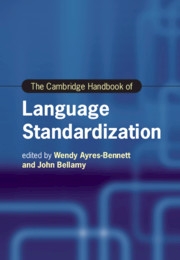Book contents
- The Cambridge Handbook of Language Standardization
- cambridge handbooks in language and linguistics
- The Cambridge Handbook of Language Standardization
- Copyright page
- Contents
- Figures
- Tables
- Contributors
- Introduction
- Part I Revisiting Models and Theories of Language Standardization
- 1 Modelling Language Standardization
- 2 Language Standardization ‘from Above’
- 3 Language Standardization in a View ‘from Below’
- 4 Social Cohesion and Emerging Standards of Hindi in a Multilingual Context
- 5 Standardization in Highly Multilingual National Contexts
- 6 Standardization of Minority Languages
- Part II Legitimacy, Authority and the Written Form
- Part III Norms, Literacy and Education
- Part IV Beyond the National
- Part V Standardization in Late Modernity
- Name Index
- Subject Index
- References
4 - Social Cohesion and Emerging Standards of Hindi in a Multilingual Context
from Part I - Revisiting Models and Theories of Language Standardization
Published online by Cambridge University Press: 01 July 2021
- The Cambridge Handbook of Language Standardization
- cambridge handbooks in language and linguistics
- The Cambridge Handbook of Language Standardization
- Copyright page
- Contents
- Figures
- Tables
- Contributors
- Introduction
- Part I Revisiting Models and Theories of Language Standardization
- 1 Modelling Language Standardization
- 2 Language Standardization ‘from Above’
- 3 Language Standardization in a View ‘from Below’
- 4 Social Cohesion and Emerging Standards of Hindi in a Multilingual Context
- 5 Standardization in Highly Multilingual National Contexts
- 6 Standardization of Minority Languages
- Part II Legitimacy, Authority and the Written Form
- Part III Norms, Literacy and Education
- Part IV Beyond the National
- Part V Standardization in Late Modernity
- Name Index
- Subject Index
- References
Summary
This chapter presents the futility of a monolithic model of standard language in the context of multilingual and multicultural India. It focuses on contact dynamics that interact in Indian multilingual and plurilingual societies to motivate speakers to accept a contact-induced variety as the norm. Conventionally, the process of standardization has been seen as promoting invariance or uniformity in language by imposing a particular variety. However, the multilingual mosaic of many countries such as India offers a model of standardization which accommodates variation to suit the specific needs of the community, granting prestige and acceptance to a non-standard variety for social cohesion. The language in question is Hindi. The chapter also draws attention to the danger of vanishing indigenous tribal languages under the pressure of one uniform standard language.
Keywords
- Type
- Chapter
- Information
- The Cambridge Handbook of Language Standardization , pp. 115 - 138Publisher: Cambridge University PressPrint publication year: 2021
References
- 1
- Cited by



